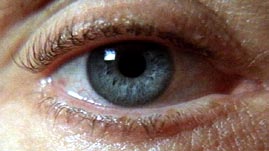When evolution skeptics want to attack Darwin's theory, they often point to the human eye. How could something so complex, they argue, have developed through random mutations and natural selection, even over millions of years?
If evolution occurs through gradations, the critics say, how could it have created the separate parts of the eye -- the lens, the retina, the pupil, and so forth -- since none of these structures by themselves would make vision possible? In other words, what good is five percent of an eye?
Darwin acknowledged from the start that the eye would be a difficult case for his new theory to explain. Difficult, but not impossible. Scientists have come up with scenarios through which the first eye-like structure, a light-sensitive pigmented spot on the skin, could have gone through changes and complexities to form the human eye, with its many parts and astounding abilities.
Through natural selection, different types of eyes have emerged in evolutionary history -- and the human eye isn't even the best one, from some standpoints. Because blood vessels run across the surface of the retina instead of beneath it, it's easy for the vessels to proliferate or leak and impair vision. So, the evolution theorists say, the anti-evolution argument that life was created by an "intelligent designer" doesn't hold water: If God or some other omnipotent force was responsible for the human eye, it was something of a botched design.
Biologists use the range of less complex light sensitive structures that exist in living species today to hypothesize the various evolutionary stages eyes may have gone through.
Here's how some scientists think some eyes may have evolved: The simple light-sensitive spot on the skin of some ancestral creature gave it some tiny survival advantage, perhaps allowing it to evade a predator. Random changes then created a depression in the light-sensitive patch, a deepening pit that made "vision" a little sharper. At the same time, the pit's opening gradually narrowed, so light entered through a small aperture, like a pinhole camera.
Every change had to confer a survival advantage, no matter how slight. Eventually, the light-sensitive spot evolved into a retina, the layer of cells and pigment at the back of the human eye. Over time a lens formed at the front of the eye. It could have arisen as a double-layered transparent tissue containing increasing amounts of liquid that gave it the convex curvature of the human eye.
In fact, eyes corresponding to every stage in this sequence have been found in existing living species. The existence of this range of less complex light-sensitive structures supports scientists' hypotheses about how complex eyes like ours could evolve. The first animals with anything resembling an eye lived about 550 million years ago. And, according to one scientist's calculations, only 364,000 years would have been needed for a camera-like eye to evolve from a light-sensitive patch.


 Loading Standards
Loading Standards Teachers' Domain is proud to be a Pathways portal to the National Science Digital Library.
Teachers' Domain is proud to be a Pathways portal to the National Science Digital Library.
